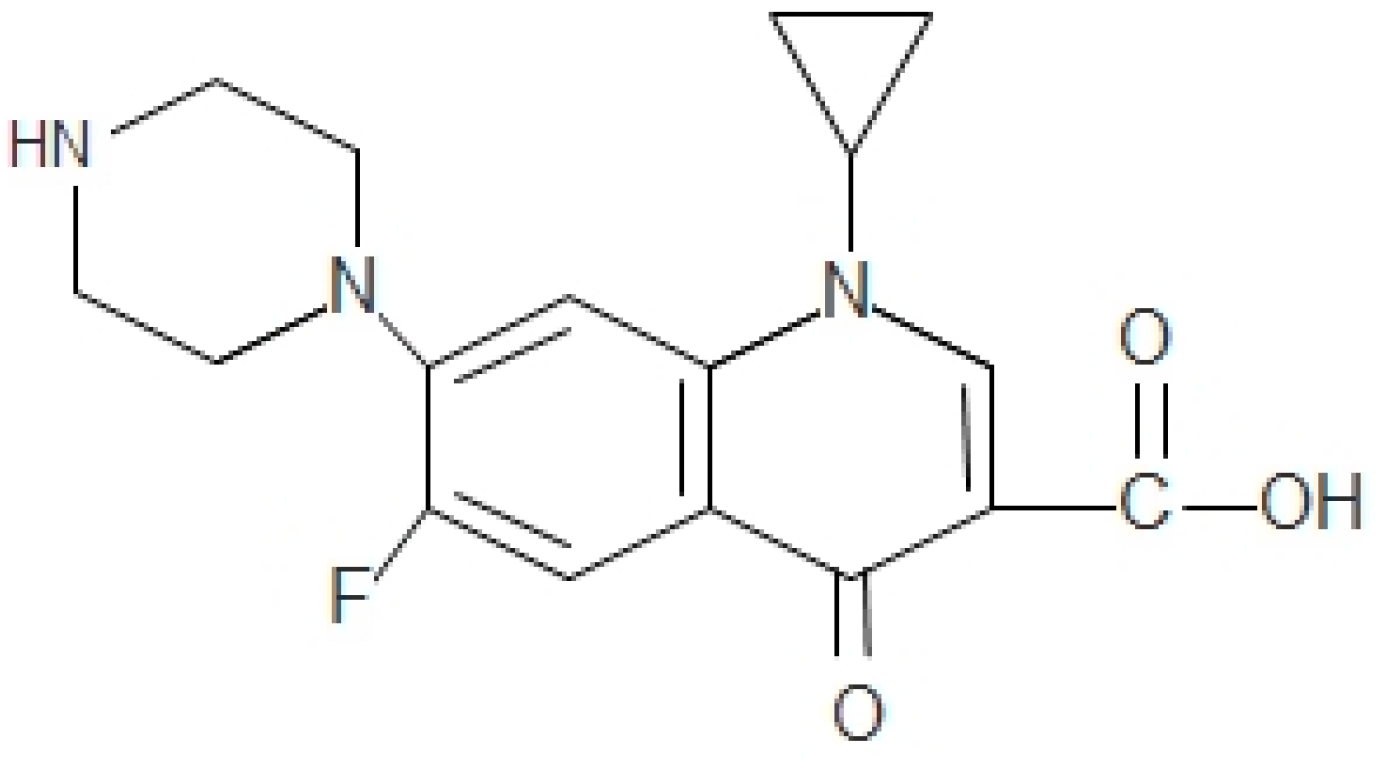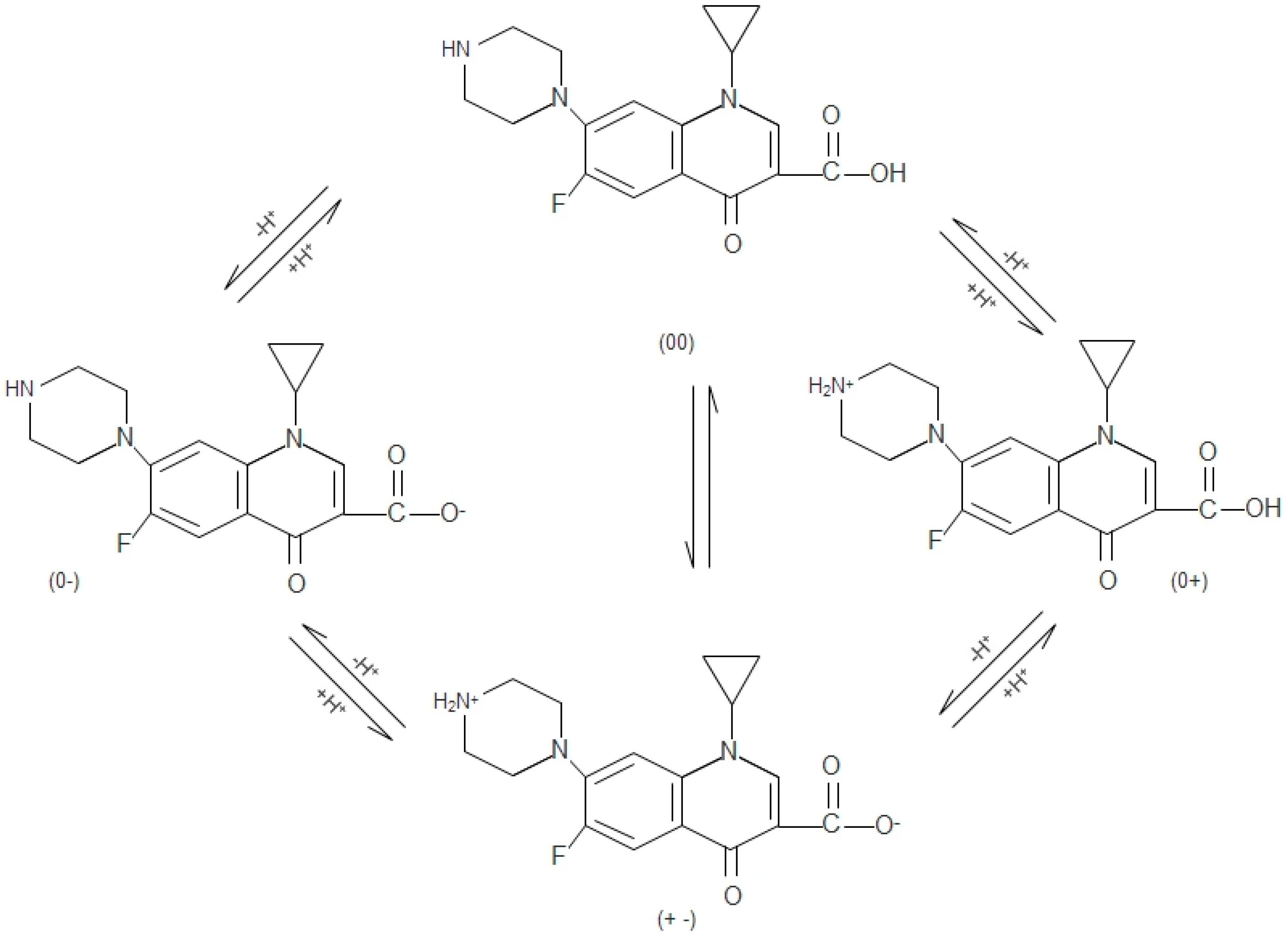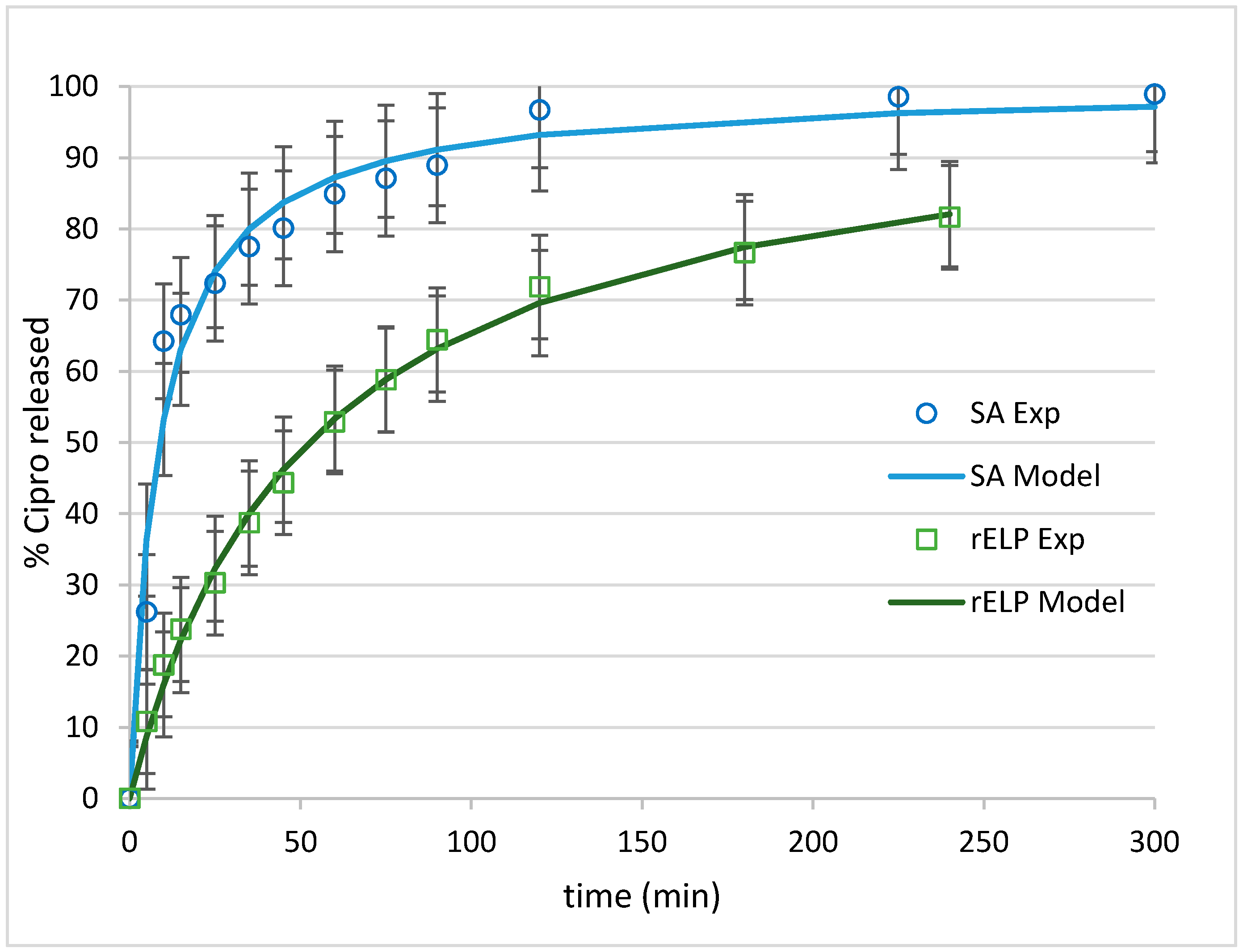Ciprofloxacin Release from Polymeric Films. Modeling and Pharmaceutical Parameters Determination †
Abstract
:1. Introduction
2. Experiments
2.1. Materials
2.2. Cuantification of Ciprofloxacin
2.3. rELP Films Preparation
2.4. Sodium Alginate Films Preparation
2.5. In Vitro Drug Release Tests
2.6. Data Analysis
3. Results and Discussion
In Vitro Drug Release Tests
4. Conclusions
Institutional Review Board Statement
Informed Consent Statement
Data Availability Statement
References
- Islan, G.A. Estudios De Liberación Controlada De Quinolonas Empleando Biopolímeros. In Facultad De Ciencias Exactas; Universidad Nacional De La Plata: La Plata, Argentina, 2009; p. 28. [Google Scholar]
- Ebokwa, C.; Okeri, H. Aqueous Solubility of Ciprofloxacin in the Presence of Metal Cations. Trop. J. Pharm. Res. 2007, 4, 349–354. [Google Scholar] [CrossRef]
- Sectretaría De Políticas, Regulación E Institutos. Expediente Número 1-0047-0000-0074650-12-8; Anmat, M.D.S.D.L.N.; Buenos: Aires, Argentina, 2012. [Google Scholar]
- Kariminia, S.; Shamsipur, A.; Shamsipur, A.M. Analytical Characteristics and Application of Novel Chitosan Coated Magnetic Nanoparticles as an Efficient Drug Delivery System for Ciprofloxacin. Enhanced Drug Release Kinetics By Low-Frequency Ultrasounds. J. Pharm. Biomed. Anal. 2016, 129, 450–457. [Google Scholar] [CrossRef] [PubMed]
- García-Astrain, C.; Avérous, L. Synthesis and Evaluation of Functional Alginate Hydrogels Based On Click Chemistry for Drug Delivery Applications. Carbohydr. Polym. 2018, 190, 271–280. [Google Scholar] [CrossRef] [PubMed]
- Rodríguez-Cabello, J.C.; Girotti, A.; Ribeiro, A.; Arias, F.J. Synthesis of Genetically Engineered Protein Polymers (Recombinamers) as an Example of Advanced Self-Assembled Smart Materials. Methods Mol. Biol. 2012, 811, 17–38. [Google Scholar] [PubMed]
- Vallejo, F.J.A.; Alonso, M.; Rodríguez-Cabello, J.C.; Síntesis, Y. Caracterización De Nuevos Polímeros Recombinantes Tipo Elastina Fusionados A Egfp Para La Formación De Nanopartículas. In Bioforge; Universidad De Valladolid: Valladolid, Spain, 2015. [Google Scholar]
- Fernández-Colino, A.; Bermudez, J.M.; Arias, F.J.; Quinteros, D.; Gonzo, E. Development Of A Mechanism And An Accurate And Simple Mathematical Model For The Description of Drug Release: Application To A Relevant Example Of Acetazolamide-Controlled Release From A Bio-Inspired Elastin-Based Hydrogel. Mater. Sci. Eng. C Mater. Biol. Appl. 2016, 61, 286–292. [Google Scholar] [CrossRef] [PubMed]
- Romero, A.I.; Villegas, M.; Cid, A.G.; Parentis, M.L.; Gonzo, E.E.; Bermúdez, J.M. Validation of Kinetic Modeling of Progesterone Release from Polymeric Membranes. Asian J. Pharm. Sci. 2018, 13, 54–62. [Google Scholar] [CrossRef] [PubMed]
- U.S.P.34-N.F.29 In Vitro and In Vivo Evaluation of Dosage Forms. United States Pharmacopeia Convention; United States Pharmacopeial Convention: Rockville, MD, USA, 2011; pp. 612–617. [Google Scholar]
- Costa, P.; Lobo, J.M.S. Modeling and Comparison of Dissolution Profiles. Eur. J. Pharm. Sci. 2001, 13, 123–133. [Google Scholar] [CrossRef]



| Polymer | rELP | SA | ||||
|---|---|---|---|---|---|---|
| Thickness (µm) | 342 | 465 | 261 | 47 | 44 | 59 |
| Weights (g) | 0.0244 | 0.0234 | 0.0199 | 0.0033 | 0.0039 | 0.0052 |
| Model Lumped Parameters | Pharmaceutical Relevant Parameters | |||||
| Platform Polymer | a ± sd * | b ± sd * | M∞ | t80% (min) | MDT80% (min) | DE200min (%) |
| SA | 11.396 ± 3.245 | 0.114 ± 0.0375 | 0.2709 | 35.10 | 8.88 | 66.63 |
| rELP | 1.907 ± 0.165 | 0.019 ± 0.002 | 0.5605 | 209.76 | 53.06 | 58.79 |
Publisher’s Note: MDPI stays neutral with regard to jurisdictional claims in published maps and institutional affiliations. |
© 2020 by the authors. Licensee MDPI, Basel, Switzerland. This article is an open access article distributed under the terms and conditions of the Creative Commons Attribution (CC BY) license (https://creativecommons.org/licenses/by/4.0/).
Share and Cite
Nieva, C.A.B.; Villegas, M.; Romero, A.I.; Cid, A.G.; Campos, S.N.; Gonzo, E.E.; Vallejo, F.J.A.; Bermúdez, J.M. Ciprofloxacin Release from Polymeric Films. Modeling and Pharmaceutical Parameters Determination. Proceedings 2021, 78, 8. https://doi.org/10.3390/IECP2020-08693
Nieva CAB, Villegas M, Romero AI, Cid AG, Campos SN, Gonzo EE, Vallejo FJA, Bermúdez JM. Ciprofloxacin Release from Polymeric Films. Modeling and Pharmaceutical Parameters Determination. Proceedings. 2021; 78(1):8. https://doi.org/10.3390/IECP2020-08693
Chicago/Turabian StyleNieva, Cintia A. Briones, Mercedes Villegas, Analia I. Romero, Alicia G. Cid, Santiago N. Campos, Elio E. Gonzo, Francisco J. Arias Vallejo, and José M. Bermúdez. 2021. "Ciprofloxacin Release from Polymeric Films. Modeling and Pharmaceutical Parameters Determination" Proceedings 78, no. 1: 8. https://doi.org/10.3390/IECP2020-08693
APA StyleNieva, C. A. B., Villegas, M., Romero, A. I., Cid, A. G., Campos, S. N., Gonzo, E. E., Vallejo, F. J. A., & Bermúdez, J. M. (2021). Ciprofloxacin Release from Polymeric Films. Modeling and Pharmaceutical Parameters Determination. Proceedings, 78(1), 8. https://doi.org/10.3390/IECP2020-08693





